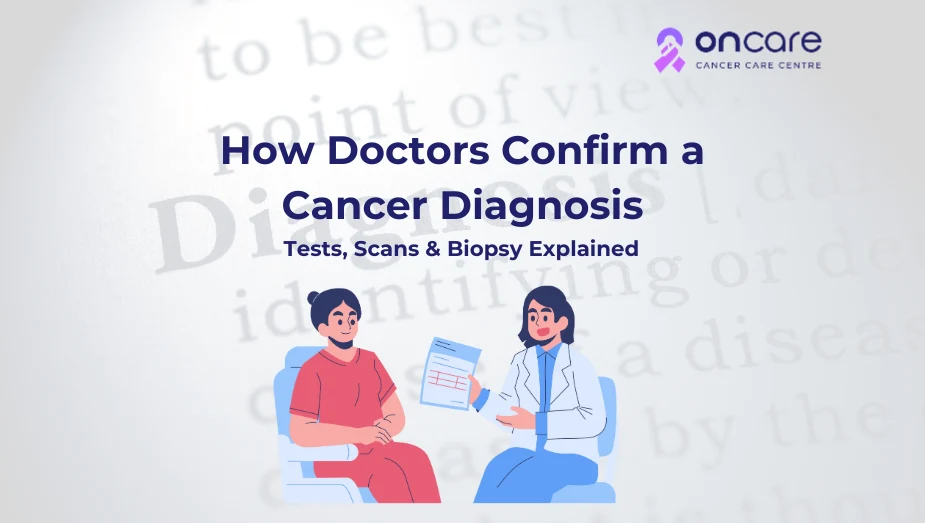Table of Contents
How Doctors Confirm a Cancer Diagnosis: Tests, Scans & Biopsy Explained

People who wake up consistently tired or weak and start to notice any unusual lumps or any sense of off-balance in their body often dismiss these signs in the first place; many of them ignore or overlook this. Most of us consider these symptoms to be just usual stress or fatigue. In most cases, these are the most ordinary signs that hint at something more serious than any normal fatigue. That’s when the finest doctor's role plays out; they’ll try to find out if cancer could be the reason for this infinite fatigue or lumps in the body.
In this blog, we’ll discover more about how an initial suspicion leads to a cancer diagnosis, what are the major diagnosis procedures used in the patients.
How do doctors confirm cancer diagnosis?
Before starting any major medical tests and scans, doctors usually analyze the suspected patient’s previous medical history for an initial assessment, and if they find any major conclusions, then the doctors might proceed for a physical examination.
Analysing medical history and physical examination
- Medical history: Doctors often ask about any specific symptoms, along with the patient's lifestyle and family history of cancer and previous illness.
- Physical examination: The doctors often check for any signs of visible lumps and skin changes, along with swelling and tenderness in the affected areas.
These are the major steps to help with further diagnosis procedures; tests and scans are necessary to confirm the cancer.
Laboratory tests
Performing laboratory tests including blood tests and urine tests often helps to find out any abnormalities caused by the cancer disease.
Some of these tests may include:
- Complete Blood Count (CBC) : Performing a CBC test in a suspected patient helps to determine the unusual counts of blood cells including red blood cells, white blood cells, and platelets.
- Tumor Marker Tests : Performing a tumor marker test in people helps to measure any type of specific proteins usually found in certain types of cancers.
- Urinalysis : It helps to detect any type of abnormal cells or substances that suggest the sign of cancer.
Keep in mind that performing lab tests alone can’t confirm the cancer, but these test results will often lead to more medical evaluations and tests.
Imaging scans to find out any abnormalities
Performing imaging tests often allows your doctor to determine bones and internal organs in a non-invasive way. This often means that performing these scans often help the doctors to see inside of the body without any surgery.
Imaging tests used in diagnosing cancer may include:
- CT scans : Performing a CT scan helps to create more detailed cross-sectional images to show any types of tumor spread in the suspected patients.
- Ultrasound : These tests use sound waves to detect any types of lumps of fluid buildup in the suspected or cancer patients.
- MRIs : Performing MRIs offers the chance to discover high-detail images, especially for organs like the brain, spinal cord, or soft tissues.
- PET Scan : Performing these scans helps to highlight any type of active cancer cells using a special type of dye.
- X-Rays : Performing X-rays on suspected patients helps to find out any types of tumors, bone damage or lung issues.
Biopsy
Performing a biopsy on a suspected cancer patient is a way to determine exactly what’s going on in your body. In a biopsy, a healthcare provider usually removes the sample of tissues, and later a medical pathologist examines them for any signs of cancer.
There are several types of biopsies, these may include:
- Needle biopsy
- Endoscopic biopsy
- Surgical biopsy
- Bone marrow biopsy
- Cone biopsy
- Liquid biopsy
- Punch biopsy
- Sentinel lymph nodes
- Shave biopsy
A medical pathologist often examines the sample under a microscope to detect if the cancer cells are present. Whether it has spread, what type of cells are present, and how aggressive they may be.
Genetic and Molecular testing
In modern cancer care, an oncologist often performs the genetic profiling of the cancer cells. Doctors use genetic and molecular testing in suspected cancer patients to detect any types of cancer mutations that drive cancer growth in the patients.
Performing these tests also helps to design personalized cancer treatments, including surgery, chemotherapy, targeted therapy, and immunotherapy.
Cancer staging
Cancer staging is a way to measure the extent of cancer growth in a suspected patient’s body. This procedure also helps to confirm the suspicion of cancer in some people. The cancer staging also helps with measuring the treatment patterns and outcomes in a patient.
When the cancer is confirmed in a patient, the oncologists will later move to determine the stage of the cancer. It helps to analyse how far the cancer has spread in the body.
- Stage I : This is a localized cancer
- Stage II: The tumor is grown larger and possibly spread to nearby lymph nodes
- Stage III: The tumor has grown deeper into the surrounding tissues, generally spread to nearby lymph nodes
- Stage IV: The cancer has spread metastasized, which is outside of the original site
Consult Today
Confirming a cancer diagnosis is the same as navigating through a complicated set of medical procedures, while uncertainty gives way to clarity, with each test serving to increase understanding about cancer. The diagnosis process evolves from initial suspicion to definitive diagnosis, informed by imaging, lab tests, and the microscopic truth provided by a biopsy.
At Oncare, we offer premium-quality cancer treatments including advanced cancer surgeries at affordable price ranges with an experienced cancer specialist consultation.
If you or any loved ones of yours are diagnosed with cancer, then visit Oncare Cancer Center and book an appointment with our cancer specialist consultation. Get an estimated cost of your cancer treatment today!
Frequently Asked Questions
Here are some approaches used by cancer.
- Physical examination
- Lab tests
- Imaging tests
- Biopsy
Here are some of the major blood tests performed to diagnose many types of cancer.
- Complete Blood Count (CBC)
- Tumor marker blood tests
- Blood protein tests
- Circulating tumor cell (CTC) tests
Here are some major types of biopsies.
- Bone marrow biopsy
- Cone biopsy
- Excisional biopsy
- Incisional biopsy
- Liquid biopsy
- Needle biopsy
- Punch biopsy
- Shave biopsy
- Sentinel lymph nodes

